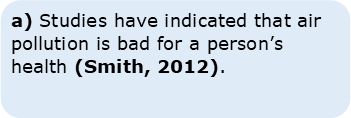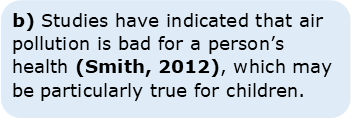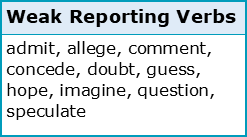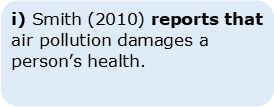Should I mix integral and non-integral citations?

This is the second of three chapters about Citation Types. To complete this reader, read each chapter carefully and then unlock and complete our materials to check your understanding.
– Discuss the differences between integral and non-integral citation types in academic contexts
– Explore the rules, forms and uses of non-integral citations
– Explore the rules, forms and uses of integral citations
Before you begin reading...
-
video and audio texts
-
knowledge checks and quizzes
-
skills practices, tasks and assignments
Chapter 2
In this second chapter on citation types, we next discuss in specific detail the two types of citation that students are most likely to use, called integral and non-integral citations. We first explore these two types in detail, using examples to demonstrate to students the most appropriate situations for their use, before then exploring the benefits of using a mixture of both styles to balance voice in academic essays.

What are non-integral citations?
The most common citations that students will see and use are of the non-integral type, in which all of the citation elements are placed within brackets – such as the authors’ family names, the year of publication, and any necessary page numbers or webpage URLs. As can be seen in the examples below, such citations are normally placed at the end of a sentence (a) or at the end of a clause (b):


What are integral citations?
The second citation type, and one that is also commonly used, is the integral citation, which conversely does not contain all of its reference elements inside brackets as the non-integral citation does. Used to change the focus from the research to the researcher, integral citations place the source authors’ names outside of the brackets and may be introduced either within a prepositional phrase (c) or as the main subject of a clause or sentence (d):


How are reporting verbs helpful?
What you may have noticed in example (d) is that most integral citations require the addition of a reporting verb such as ‘argue’, ‘claim’ or ‘suggest’ immediately after the citation in order to introduce the source information. As can be seen in the tables below, such reporting verbs can be categorised into neutral, weak and strong types, allowing the writer to modify how that information is reported:



As the following three examples demonstrate, by changing the reporting verb that follows the integral citation, a writer can modify the hedging language used to indicate degrees of certainty between the source author and the source information:



How do citations help to balance ‘voice’?
Within a piece of academic writing, it’s also possible to include three different types of voice: writer voice (WV), source voice (SV) and mixed voice (MV). It’s important that students are able to balance voice in their writing, clearly showing to the reader which ideas are their own (WV), which are from other sources (SV) and which ideas both the writer and the source generally share (MV) – attempting also to provide a balance of all three.

As the following paragraph shows, it is by using a mixture of omitted citations, integral citations and non-integral citations that students can carefully manipulate the balance of voice in their writing. After reading this example paragraph, students may wish to take our short writing skills reader on balancing voices to improve their knowledge of how citations can be used in this way:
PM2.5 air pollution may be one of the most important contributing factors to the global increase in lung cancer.WV Research suggests that as air pollution has increased in Asia, so too have the number of respiratory conditions being reported.WV As Smith (2012) explains, there has been a 250% increase in PM2.5 emissions in India in the last 10 years alone, correlating with a 85% increase in lung-cancer diagnoses.SV These findings indicate that PM2.5 emissions and lung cancer are inextricably linked (Jones, 2017).MV Indeed, Lee and Lee (2014) argue that by spending only one hour per day in air that is higher than 100 on the PM2.5 scale, people are up to 20% more likely to report significant respiratory conditions in later life.SV However, whether there are other variables causing these health disorders is currently unclear.WV Because most studies were conducted in areas that additionally had high concentrations of Volatile Organic Compounds (Snow et al., 2018), such VOCs may be just as detrimental to health as PM2.5.MV At this stage, more research is required into both PM2.5 and VOCs to determine how these impact a person’s long-term respiratory health.WV
Having now explored both integral and non-integral citation types, students may next wish to complete our Chapter 2 activities to check their progress and understanding of these topics. Following those activities, our third and final chapter on citation types focuses on recognising, using and understanding both multiple-source and secondary citation types.
Please note: while there are many different possible referencing styles such as APA or Chicago, all examples demonstrated in this chapter are of the Harvard Style of referencing as described in the book Cite Them Right.
To reference this reader:
Academic Marker (2022) Citation Types. Available at: https://academicmarker.com/academic-guidance/referencing/referencing-features/citation-types/ (Accessed: Date Month Year).
Downloadables
Once you’ve completed all three chapters in this short reader about Citation Types, you might then wish to download our Chapter Worksheets to check your progress or print for your students. These professional PDF worksheets can be easily accessed for only a few Academic Marks.
Chapter 1 explores the topic: What are the four types of academic citation? Our Chapter 1 Worksheet (containing guidance, activities and answer keys) can be accessed here at the click of a button.
Lesson 2 explores the topic: Should I mix integral and non-integral citations? Our Chapter 2 Worksheet (containing guidance, activities and answer keys) can be accessed here at the click of a button.
Chapter 3 explores the topic: How can I use multiple and secondary citations? Our Chapter 3 Worksheet (containing guidance, activities and answer keys) can be accessed here at the click of a button.
To save yourself 2 Marks, click on the button below to gain unlimited access to all of our Citation Types Lesson Worksheets. This All-in-1 Pack includes every lesson, activity and answer key related to this topic in one handy and professional PDF.
Collect Academic Marks
-
100 Marks for joining
-
25 Marks for daily e-learning
-
100-200 for feedback/testimonials
-
100-500 for referring your colleages/friends